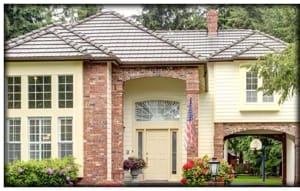
One of the most important decisions for a homeowner includes finding the right siding for your home. Siding not only protects your house, but it also adds beauty and value to your home. What home siding options are there? TGUC Financial can help you with the siding replacement cost.
There are numerous different material options to choose from for house siding including wood, metal, stone, brick, vinyl, fiber cement, stucco and many more. However, there is more to choosing siding than just looking at the materials basing your choice on its appearance. Let us dive deeper to also see the options of each kind.
Brick Home Siding Options
Just like stucco, brick can be considered in the stone category, but it has more than enough reasons to stand on its own. Not only does it provide aesthetics but its primary material is fired clay which is composed of cement and gravel. This composition contributes to its durability and will last lifetime. Buildings of brick masonry can also be better at cooling down during hot weather than those that are framed and sided.
There are 3 siding variations for brick homes. 2 are brick veneer siding options for when a home is fully constructed. In the third option, bricks are actually the structural component of brick homes. Bricks require very little maintenance, buty they will eventually deteriorate at the mortar joints.
On the other hand, brick veneers are on the outside of the home’s structure, either as single-layer full brick, or thin brick which is not recommended.
Vinyl
Vinyl is the number 1 residential siding material in the United States, due to several factors. Technically, it is called polyvinyl chloride or PVC which is then always shortened to “vinyl”. It remains one of the most affordable materials to install, is low maintenance, and is very versatile as well. Vinyl siding also comes with a range of colors and designs to choose from, including wood grain patterns. So with these qualities, it really is hard to beat. However, just like other materials, it has its downsides as well because it may be low maintenance but mold and grime build up can happen.
Vinyl siding has almost no boundaries because there’s not a style it can’t match. Style options with vinyl include bevel, shake and shingle, vertical planks, and even split log.
Wood
Wood has many options depending on how it is installed including shingles, board-and-batten, split-log, and bevel. It has numerous sub-options as it can be cut or shaped in many ways. It also has several grains and thousands of colors to choose from.
In choosing the right wood species and grade, remember to ask your contractor about the splitting, checking, cupping, and rot resistance. Wood may have a variety of siding options to choose from (such as pine, spruce, fir, cedar, redwood) but not all may be suited to your location, region and climate.
Engineered wood siding is included in this category. It is also known as man-made wood, composite wood, or manufactured wood. Homeowners who love the classic look of wood siding but don’t want to deal with its high maintenance should choose this wood siding. Although prone to moisture invasion, it is cheaper, easier to install, and most of all, an eco-friendly alternative to high-maintenance natural wood which obviously comes directly from timber.
Stucco
Stucco is really a plaster as it is made from cement, sand, and lime. It has developed from the standard white-washed model to a wide range of textures and colors. The binding materials composing exterior grade stucco are meant to withstand weather. It is breathable which allows the quick evaporation of moisture, it may be ideal for locations with normal precipitation but not for rainy areas. Materials are not that costly, but there’s a definite increase in labor costs as stucco needs the application of three coats.
Stone
Like wood, it has natural beauty and has man-made or manufactured versions which are less pricey. It has two options, natural stone and faux stone which is also known as cast or manufactured stone veneer (MSV).
MSV products recently became a popular siding option. They are made from a mixture of lightweight aggregate, Portland cement, and iron-oxide pigments. The look really is a carbon copy and installation costs are considerably less than that of natural stone. However, it isn’t as durable as the real deal.
Fiber Cement
Fiber-cement siding—typically made from Portland cement, sand, and cellulose fibers—is impervious to wood-boring insects, rot, deterioration from salt and ultraviolet rays. It also carries a 1A fire rating and is available in a full range of wood-like lap and shingle styles and colors.
It is commonly known as James Hardie, the original company to produce this fiber cement type of plank board. The name is synonymous with the material and sometimes referenced generically as cement board.
Not only is it available in a wide range of wood-like lap and shingle styles and colors, it carries a 1A fire rating as well. Fiber cement is almost as durable as vinyl with the plastic look aside. Refinishing or repainting become necessary after about 15 years, so it can last between 50-100 years and requires low maintenance.
Aluminum Home Siding Options
Metal siding is very versatile and malleable. Although it tends to have its own style, such as corrugated sheets, it can be shaped into any style. Aluminum is the primary option for metal siding.
Aluminum siding is popular among coastal homeowners because of its rust resistance. It being low cost and low maintenance make it a practical option for most homes around the country. However, as metal sidings are malleable, aluminum is prone to dings and dents. It can also lose its original luster overtime, but that can be handled with repainting.
TGUC Financial and Financing for Home Siding Options
TGUC Financial can help you with sinding replacement. Don’t put off finishing your plumbing. Contact us today.
